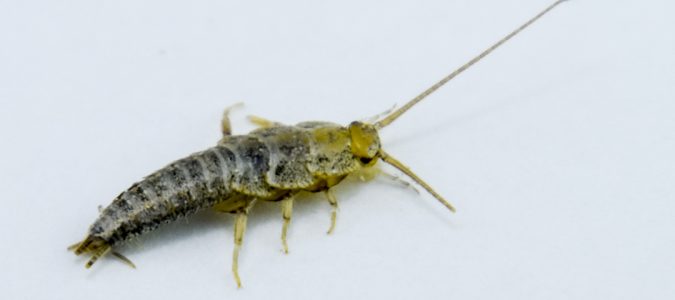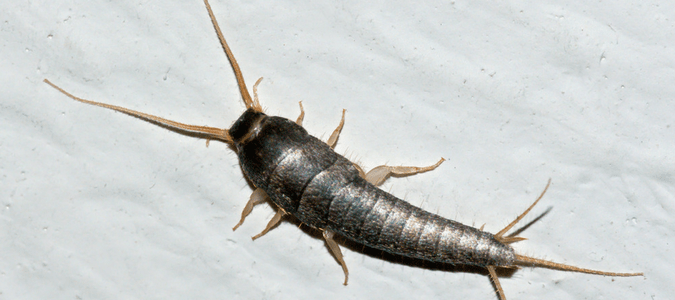Silverfish are very small, wingless insects. Silverfish eggs are so tiny, they’re hard to see without a magnifying glass. Baby silverfish, or nymphs, are also very, very small. Adult silverfish grow to about a half-inch long and just an eighth of an inch wide. They get their name from their interesting appearance: They are a silvery-gray color, and they are covered in what look like fish scales. Their long, narrow bodies also move on their tiny legs in a side-to-side way that looks like fish swimming in water.
Silverfish have long antennae on their heads as well as long, tail-like spikes coming out of their hind ends. They actually look a little bit like shrimp, although they don’t live in water. They live either outdoors or in our houses, where they can cause hidden damage to our things.
Silverfish are attracted to moisture and humidity. Outside, these insects might be found in mulch, piles of leaves or thick weeds that don’t dry out completely after a rain. Indoors, people are most likely to see them in bathrooms, laundry rooms and basements, since these are the areas of our homes with the most moisture.
These insects aren’t just gross. They can also cause damage to books and wallpaper, since they feed on the cellulose found in paper goods. They also munch on clothes, towels, sheets, blankets and even carpet. Silverfish have also been known to infest grain products in people’s pantries, like pasta, oats or cereal.
Silverfish can live for several years, but since they are nocturnal—meaning, mostly active at night—you may not see them very often. Still, they can infest lots of different areas of the home and cause hidden damage to your belongings. This is why it’s important to address the problem once you realize you have a silverfish infestation.
Preventing Silverfish Problems
There are several things you can do on your own to keep silverfish away from your home and to keep their numbers low. Outdoors, focus on ways to help damp areas of your yard dry out more quickly. This might mean trimming back bushes, keeping the grass cut short and weeds under control, or fixing low spots that tend to accumulate water after a rain.
Another spot to pay close attention to is the foundation of your home, since this is where silverfish might get in from outside. Be sure to keep firewood stacked far away from your home and trim back any vegetation that’s near the foundation. Any cracks in the exterior walls or foundation will need to be sealed up to keep silverfish and other pests out.
If you have moisture issues inside your home, a dehumidifier will help keep silverfish at bay. Be sure to fix any leaky faucets or pipes, since these can create damp conditions that attract silverfish. These pests are also attracted to paper, so clearing away paper clutter will help. Finally, silverfish can even feed on dust. Generally keeping your home clean, dusted and vacuumed will go a long way toward getting rid of these pests.
Taking these steps may not be enough to get rid of silverfish. Hiring a pest control professional is the best way to deal with an ongoing silverfish infestation. A pro can inspect your home and recommend the right treatment methods and products to eliminate these pests. They can also help you determine if you have silverfish or house centipedes.
What Do Silverfish Eat?
What do silverfish eat? In nature, they eat cellulose—the material within wood and plant fibers that gives them their structure. Paper is made from wood, so cellulose is present in all kinds of paper products. This is why silverfish that get into a home often damage paper goods like books, magazines, old photographs, wall art and wallpaper.
These pests aren’t limited to just paper items, though. Silverfish can also feed on dust inside a home. They also eat actual food products like dried beans and pasta, cereal, oats and flour. Keeping these items inside airtight containers in your pantry will protect them from silverfish as well as other pests.
Silverfish can also feed on things made out of fabric. They might damage sheets, blankets, towels, clothes or carpet by chewing on them over time. In many homes, there are closets located in or near bathrooms. Since bathrooms tend to be damp, this can lead to silverfish damaging anything kept inside the closet, like clothes, towels and linens.
Usually, silverfish don’t chew actual holes through paper or clothing, like other pests might. Instead, they feed off the items’ top layer. This causes thin spots, or areas that look shaved down. In the case of clothes and bedding, holes can develop when the thin spots break down over time.
Silverfish are mostly active at night, under the cover of darkness. They can live for several years, as long as they have the food, water and shelter needed to survive. This is why the damage they cause can go unnoticed for a long time.
Identifying Silverfish Damage
When people do spot silverfish damage, they may not realize at first what they’re seeing. It might look like a cluster of thinning spots on wallpaper or on the pages of a book. You might see similar spots on folded blankets or sheets in the linen closet. You might even see actual holes, if enough time has passed that the fibers have broken down completely. The thinning spots could look a bit like lace, especially when held up to the light.
If you see spots like these on things in your home that are made of paper or fabric, it’s time to call in a pest control specialist with experience in treating silverfish. Silverfish infestations can grow out of control if they aren’t found and treated. Silverfish aren’t dangerous to humans—they don’t bite or carry diseases. But the damage they can cause to things you care about is real. A pest control professional knows how to spot the signs of silverfish and how to get rid of these pests.
How to Identify Silverfish Eggs
Silverfish eggs are smaller than a millimeter in length—so tiny that they are hard to see with the naked eye. These pests also typically lay their eggs in tiny cracks and crevices. This makes the eggs even harder to find. But if you know where to look, you can grab a flashlight and a magnifying glass to see them.
Silverfish eggs are brownish in color and semi-translucent. You might find them in warm, moist places like your bathroom or laundry room. You won’t find them out in the open, though. Check cracks between floorboards or between the baseboard and the wall. If there is wallpaper on the walls that is peeling up in areas, you might see silverfish eggs behind the wallpaper. These tiny, protected spots are the most likely places to find these pests’ eggs.
A good silverfish control plan will include eliminating these pests’ eggs. If you treat only active adult insects but don’t also treat their eggs and nymphs, you won’t be addressing the whole problem. A licensed, reputable pest control professional will include all phases of the silverfish life cycle in their plan to get rid of this pest.
How to Get Rid of Silverfish
It can feel very creepy to spot silverfish in your home. If you’re wondering how to get rid of silverfish, be forewarned that it may not be easy. These tiny insects are nocturnal, which means they are most active at night, in the dark. They also happen to feed on lots of things people like to keep around. This includes books, magazines, bedding and clothes.
Even their small size and how fast they move can make silverfish hard to find and eliminate. As soon as you spot one, it will probably run away and hide. Still, there are things you can do to get rid of these pests. The best place to start is outside in your yard. This is because most silverfish come from outdoors and make their way inside when they find the right conditions.
Getting Rid of Silverfish Outside
They live outside in damp areas like piles of mulch or leaves. Mowing your grass, eliminating weeds, and resolving drainage issues in your yard will all help keep silverfish away. Keeping mulch, weeds and stacked firewood well away from your house will also help. These pests often access the indoors through tiny cracks in your foundation or exterior walls. Sealing off cracks and gaps will keep lots of pests out, including silverfish.
Getting Rid of Silverfish Inside
Eliminating moisture and humidity indoors is also very important in keeping silverfish away. Fix any leaks, including leaky pipes or faucets. Use a dehumidifier in basements or other areas that are constantly damp. Since silverfish eat paper goods, it’s best not to keep cardboard boxes or stacks of paper around. Keep the foods in your pantry and on countertops stored in airtight containers to keep all types of pests out.
All of these steps should go a long way toward keeping silverfish populations low in your home. If you have an active infestation, though, these steps may not be enough to get rid of these pests. In this case, it’s wise to call on a pest control specialist to develop a customized extermination plan. The plan should be comprehensive, including several different strategies, and should address all stages of the insect’s life cycle.
ABC Can Control the Silverfish on Your Property
Instead of struggling with a silverfish infestation on your own, contact ABC Home & Commercial Services. Our professionals will create a thorough pest treatment plan to get rid of these pests. That way, you don’t have to worry about any more damage to your belongings.



